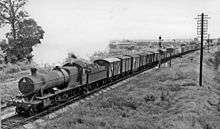GWR 2884 Class
|
3822 at Didcot | |||||||||||||||||||||||||||||||||||||||||||||||||||||
| |||||||||||||||||||||||||||||||||||||||||||||||||||||
| |||||||||||||||||||||||||||||||||||||||||||||||||||||
| |||||||||||||||||||||||||||||||||||||||||||||||||||||
| |||||||||||||||||||||||||||||||||||||||||||||||||||||
The Great Western Railway (GWR) 2884 Class is a class of 2-8-0 steam locomotive.
History
They were designed for heavy freight work and were a development of the earlier 2800 Class. The 2884s differed from the original engines in a number of respects, the most obvious being that a more modern Collett side window cab was provided and that they were built with outside steam pipes.
Production
83 of the 2884 class were built between 1938 and 1941. Those built during the war did not have the side window to the cab, and the side window on the others was plated over. This was to reduce glare, as a precaution against enemy air attacks. [1] The windows were reinstated after the war.
The locomotives were so popular with the ex-Great Western crews that the British Railways Western Region operating authorities wanted more of the class built after nationalisation in 1948; however, this request was turned down in favour of BR Standard Class 9Fs.
Oil firing
Between 1945 and 1947, coal shortages caused GWR to experiment with oil fired 2800 locomotives. Eight of the 2884 class were converted and renumbered from 4850. The experiment, encouraged by the government was abandoned in 1948 once the extra maintenance costs were calculated and the bill had arrived for the imported oil.
1948 Locomotive Exchange Trials
The year 1948 also saw one of the 2884 class, No.3803 (now preserved), emerge remarkably successfully from the 1948 Locomotive Exchange Trials against more modern engines including the LMS 8F and the WD Austerity 2-8-0 and WD Austerity 2-10-0. It took the appearance in 1954 of the British Railways BR standard class 9F 2-10-0 to displace the 2800s from their main role of mineral haulage. Nevertheless, there was still work for them right up to the end of steam on the Western region in 1965. Six decades of service testify to the fundamental excellence of Churchward's original conception.

Preservation
Nine examples of the 2884, were saved from Woodham Brothers scrapyard in Barry, Vale of Glamorgan, South Wales:
| Number | Year Built | Withdrawn | Location | Status | Image | Notes |
|---|---|---|---|---|---|---|
| 2885 | Mar 1938 | Jan 1964 | Tyseley Locomotive Works | Stored | .jpg) |
Formerly on display at Birmingham Moor Street. |
| 3802 | Dec 1938 | Aug 1965 | Llangollen Railway | Undergoing Overhaul | .jpg) |
Currently paired with a 4,000 gallon Collett tender instead of the usual 3,500 gallon Churchward tender. |
| 3803 | Jan 1939 | Jul 1963 | South Devon Railway | Stored | .jpg) |
Based at the South Devon Railway. |
| 3814 | Mar 1940 | Dec 1964 | North Yorkshire Moors Railway | Stored |  |
Currently awaiting restoration to running condition. |
| 3822 | Apr 1940 | Jan 1964 | Didcot Railway Centre | Static Display | .jpg) |
Awaiting overhaul after being withdrawn from traffic in 2010. In 1989, 3822 was used in the Music video of the song Breakthru by the band Queen. |
| 3845 | Apr 1942 | Jun 1964 | TBC | Stored | At a private site in the West Midlands awaiting restoration. | |
| 3850 | Jun 1942 | Aug 1965 | Gloucestershire Warwickshire Railway | Undergoing Overhaul |  |
Originally restored at and operated at the West Somerset Railway, now moved to Gloucestershire Warwickshire Railway for 10-year overhaul. |
| 3855 | Oct 1942 | Aug 1965 | East Lancashire Railway | Undergoing Restoration | Being restored from ex Barry Scrapyard condition. | |
| 3862 | Nov 1942 | Feb 1965 | Northampton & Lamport Railway | Undergoing Restoration | Being restored from ex Barry Scrapyard condition to full running condition. | |
Models
Hornby Railways manufacture a model of the 2884 Class in OO gauge.
Dapol produce a model in N gauge.
References
- Whitehurst, Brian (1973). Great Western engines, names, numbers, types, classes: 1940 to preservation. Oxford: Oxford Publishing Company. pp. 28, 35, 98, 103, 140. ISBN 0-902888-21-8. OCLC 815661.
- ↑ "3822 - 2-8-0". Retrieved 22 April 2014.
External links
| Wikimedia Commons has media related to GWR 2884 Class. |
- The Story of the GWR 28XX 2-8-0s
- GWR 3862 under restoration at Northampton & Lamport Railway
- Dinmore Manor Locomotive Ltd
